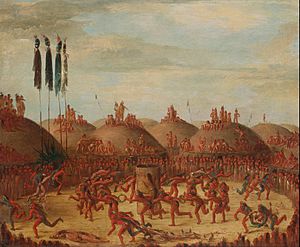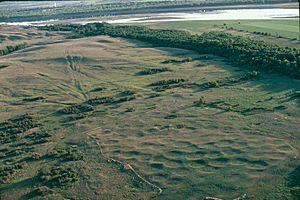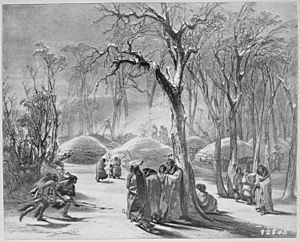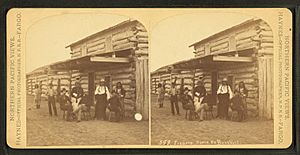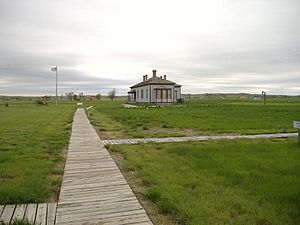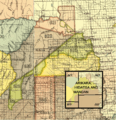Like-a-Fishhook Village facts for kids
Like-a-Fishhook Village was a Native American settlement. It was built near Fort Berthold in North Dakota, United States. This village was created by different groups from the Three Affiliated Tribes: the Mandan, Arikara, and Hidatsa. Started in 1845, it later became home to non-Native traders too. The village was an important place for trade between Native people and newcomers in the area.
The village was founded eight years after a terrible epidemic of smallpox in 1837. The number of Mandan people in the area dropped to about 125. The Hidatsa population was also affected, but not as badly. These Mandan and Hidatsa groups were later joined by the Arikara in 1862.
The village had earthen lodges and log cabins. It was left empty in the mid-1880s. The site of Like-a-Fishhook Village was lost in 1954. This happened when the Garrison Dam was built, flooding the area to create Lake Sakakawea.
Contents
- Why the Tribes Moved
- The Journey to a New Home
- Preparing the Village Site
- Choosing the Village Location
- Village Leaders and Protectors
- Life in the New Village
- The Arikara Join the Village
- A Village Under Attack
- New Neighbors and Changes
- A Split in the Community
- The Last Major Attack
- The End of the Village
- Images for kids
Why the Tribes Moved
After the smallpox year, the tribes faced many challenges. Buffalo Bird Woman, a Hidatsa elder, said that Sioux groups often attacked hunting parties. Another big worry for the Hidatsa and Mandan was that wood was running out. They lived in Big Hidatsa at Knife River. Most of the tribes agreed to build a new settlement together. They decided to move somewhere up the Missouri River.
A few Mandan stayed behind with the Arikara at their old main village, Mitutanka. Life continued as usual there until the early 1860s. Some Hidatsa stopped farming and joined the River Crow people. They moved to the Yellowstone River.
The Journey to a New Home
The move began in the spring of 1844. Hidatsa chief Four Bears and a medicine man named Missouri River led the way. The people set up a camp on the north bank of the Missouri River. This spot was called Like-a-Fishhook. It got its name because of a special bend in the river that looked like a fishhook. The Hidatsa also knew this place as "Dancing Bear."
Preparing the Village Site
Once they arrived at Like-a-Fishhook bend, families started clearing land for gardens. Their vegetable plots were located on the flat land near the river. The villagers prepared to build round, dome-shaped earth lodges. These lodges had a wooden frame inside. They spent the cold season in winter camps. The hard work of building the new village began the next year.
Choosing the Village Location
Four Bears marked the edges of the new village. Missouri River walked across the area. He sang special songs linked to his sacred bundle. He said, "I want to have the village here so my people will grow and be safe."
Village Leaders and Protectors
Besides the ceremonial leader Missouri River and the war leader Four Bears, four "Protectors of the People" were chosen. Each protector picked a spot for their earth lodge. This was so there would be a strong protector in each part of the village. Bear Looks Out cared for a Corn bundle. He chose the southern part of the village for his home. Big Cloud protected the east. The west was guarded by Bobtail Bull. Bad Horn, also Hidatsa, had a Bear bundle. His home would be in the north.
Life in the New Village
The village had a central open space called a plaza. This was new for the Hidatsa but a tradition for the Mandan. Their sacred cedar tree stood in the center. They built a special ceremonial lodge next to the plaza. Both were used during important events like the Okipa ceremony. The new village had about 70 earth lodges. The homes of important leaders faced the plaza.
Drying racks for garden produce were seen everywhere. Hidden underground were storage pits called caches. These were used to keep the summer harvest safe. Caches could be dug inside or outside the lodges. The people traded with the recently built Fort Berthold. This fort was just outside the village's northern fence. Like-a-Fishhook Village had more people than any nearby white towns.
The Arikara Join the Village
The Arikara moved out of Mitutanka when the nearby Fort Clark trading post closed in 1860. They built a new village called Star Village in the spring of 1862. This settlement was visible from Like-a-Fishhook Village, but it was on the south side of the Missouri River.
In August, a trading visit by some Sioux groups turned into a fight. The Arikara suffered many losses. They fled across the river and joined Like-a-Fishhook Village. This made the village much larger, adding a new northern area. Like the Mandans, the Arikara built a ceremonial lodge, but theirs was bigger. The arrival of the Arikara almost doubled the village's population. More than 2,000 people lived there.
A Village Under Attack
Every winter, the people moved to temporary camps in the river bottomland. These spots were better protected from cold storms. One winter, some Sioux groups set fire to Fort Berthold II. Like-a-Fishhook Village also caught fire. After heavy fighting, the men at the fort got help from some Native people in the winter camps. Buffalo Bird Woman remembered, "the Sioux came against our village in the winter time and stole our corn and burned down my father's lodge."
New Neighbors and Changes
A year before the village burned, some Yankton Sioux killed chief Four Bears. In 1864, Like-a-Fishhook Village got new neighbors. Armed forces arrived at the former trading post, Fort Berthold II. They stayed until 1867. The next year, the army built Fort Stevenson about 14 miles away. This became a new military center. However, it could not stop the Sioux's raids.
By the mid-1860s, the earth lodge was still the most common building in Like-a-Fishhook Village. The village's wooden fence was used for firewood in the winter of 1865. Like-a-Fishhook Village was now 20 years old. A burial ground with scaffolds for the dead, called open-air tombs, was behind it. However, the Arikara buried their dead in the ground. This custom was slowly adopted by the Mandan and Hidatsa tribes too.
A Split in the Community
Like-a-Fishhook Village faced a split among its residents in the early 1870s. The Hidatsa leaders Bobtail Bull, Crow Flies High, and their followers left. They built new log cabins and earth lodges near the military post Fort Buford. The tension in the village was "approaching civil war" before their departure helped calm the conflict.
The Last Major Attack
In 1874, a large group of Sioux warriors targeted Fort Berthold. George Armstrong Custer delayed his Black Hills Expedition to ride to the Fort. His orders from General Phil Sheridan said, "The Rees [Arikara] and Mandans should be protected same as white settlers." Five Arikara and "Foolish-head" (who was either Mandan or Hidatsa) died in the battle. This was the last major battle that affected the village.
The End of the Village
More and more white settlers built houses around the village. A blacksmith, a doctor, and the Indian Agent lived at Fort Berthold Agency, about a mile and a half away. Missionary Charles L. Hall taught about God in his home near the village starting in 1876. The next year, Native children could attend either the Mission School or a government-run school.
The Dawes Act of 1886 led to the end of Like-a-Fishhook Village. This act divided tribal lands into individual plots. Many Arikara had already started farming on their own plots. Their part of the village became empty, and their homes were destroyed. A few years later, only some older Mandan in the village still followed their traditional way of life. Hidatsa chief Poor Wolf led his people to new places on the reservation. An elder named Goodbird said in 1914 that "Older Indians, who came from Like-a-Fishhook Village, find their life on allotments rather lonesome. Cabins are often two or three miles apart..." The Mandan, Hidatsa, and Arikara were no longer living in large villages.
Images for kids


